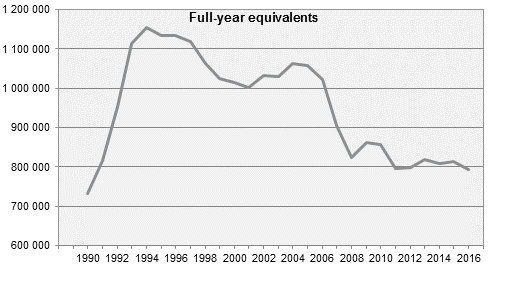Number of full-year persons receiving social assistance and benefits 2016:
Number of persons receiving economic support decreased
The number of full-year persons receiving economic support in the form of social assistance or benefits decreased by 2.5 percent in 2016 to 793 215. This corresponds to 13.8 percent of the population, which is the lowest proportion ever measured.
Every benefit system is measured in full-year persons, or full-year equivalents. This allows for comparability between the different types of benefits. The term full-year equivalent refers to the number of individuals who can be supported during an entire year on full benefits. For example, two persons who have both been unemployed full-time for six months amount to one full-year equivalent.
Statistics Sweden annually reports statistics on the number of full-year persons aged 20–64 who receive economic support in the form of social assistance or benefits, such as sickness benefits, sickness or activity compensation (formerly early retirement), unemployment benefits and economic aid.

* Sickness benefits, sickness or activity compensation, unemployment benefits, labour market programmes and economic aid.
The number of full-time equivalents rose sharply in the early 1990s; between 1990 and 1994, the number rose by almost 60 percent. With the exception of a few years, the number increased steadily until 2011. Since then the number has been largely at the same level.
The number of full-year persons with sickness or activity compensation, which accounts for about 35 percent of the total number of full-year persons, has decreased since 2006. In 2016, the number decreased by 3.1 percent to the lowest level since the reporting of full-year equivalents started in 1990.
Since 2002, the number of full-year persons with sickness benefits decreased steadily. This trend was broken in 2011, and in 2016 the number of full-year persons with sickness benefits increased for the sixth year in a row, at that time by 4.2 percent.
The number of full-year persons in the other compensation forms (unemployment benefits, labour market programmes and economic aid) decreased in 2016. The number with unemployment benefits decreased the most, by -11.1 percent.
The percentage of full-year equivalents is declining
The percentage of full-year equivalents in the working population (aged 20–64) was 14.8 percent in 1990. In 1994, this percentage peaked at 22.6 percent. In 2016, the percentage of full-year equivalents in the working population was 13.8 percent, which is the lowest percentage ever measured.
Major differences among the sexes
Among the full-year equivalents, 53.8 percent are women and 46.2 percent are men. Women are in the majority with regard to sickness benefit and sickness or activity compensation, while the number of men is higher with regard to unemployment benefits and labour market programmes. However, the number of full-time equivalents with economic aid is evenly divided among the sexes.
| Women | Men | Total | |
|---|---|---|---|
| Sickness benefits | 64.8 | 35.2 | 100.0 |
| Sickness or activity compensation | 56.7 | 43.3 | 100.0 |
| Unemployment benefits | 43.2 | 56.8 | 100.0 |
| Labour market programmes | 44.5 | 55.5 | 100.0 |
| Economic aid | 51.2 | 48.8 | 100.0 |
| Total | 53.8 | 46.2 | 100.0 |
Feel free to use the facts from this statistical news but remember to state Source: Statistics Sweden.
